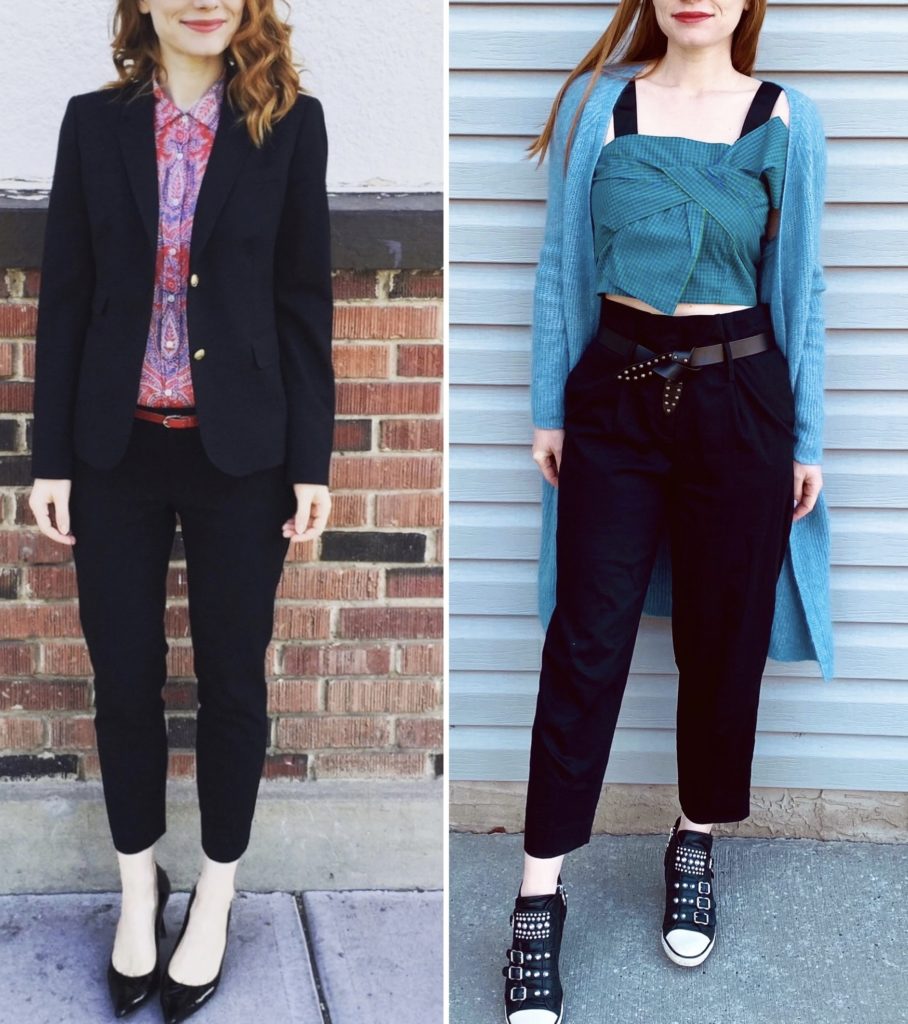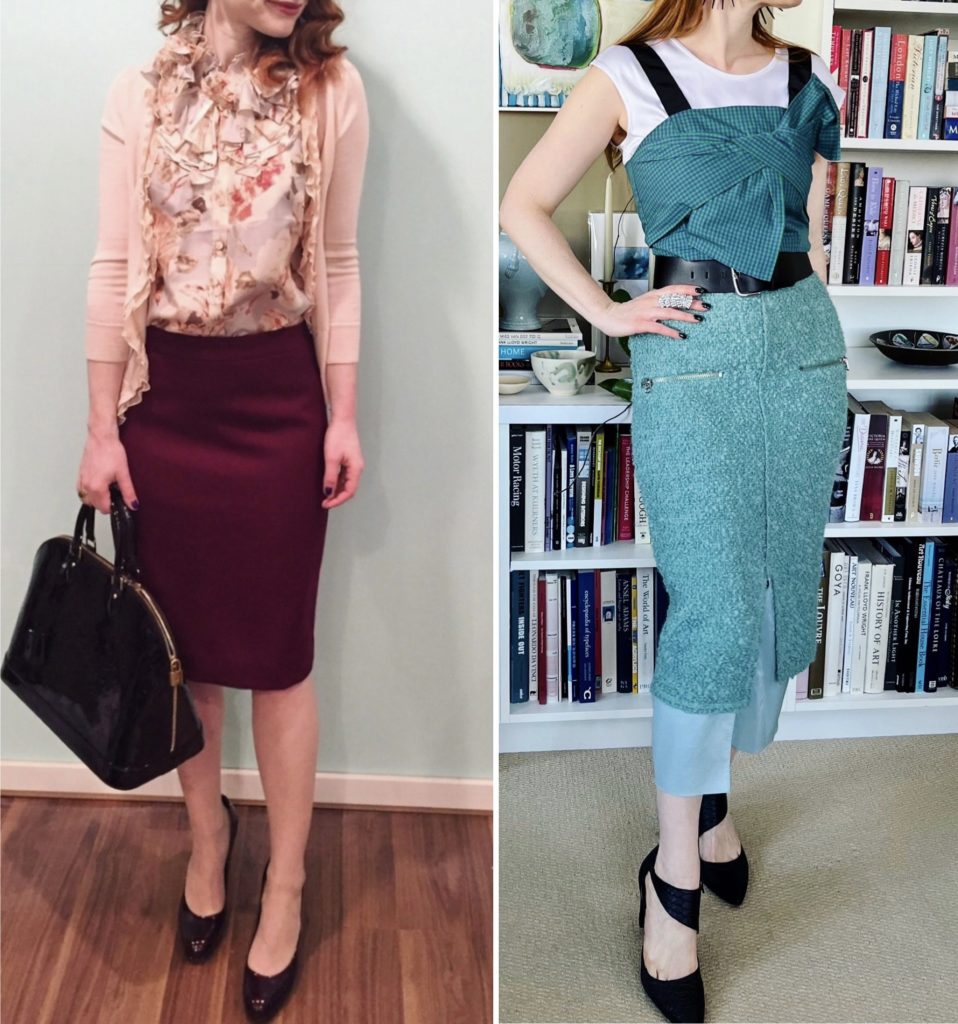I came of age in the 90s, which was not a decade known for its body positivity, and I was a devout reader of women’s magazines during that time. Looking back, I think I was desperate for clues about the “correct” ways to perform my femininity; my mother wasn’t especially interested in fashion, makeup and other “girly” pursuits, and I had no sisters nor friends with whom I felt comfortable enough to share my lack of knowledge or ask for help. Magazines helped me figure out the key rituals of femininity and how to perform them convincingly enough to feel like I could blend in with my peers to an acceptable degree; but all that information came with a heaping side of internalized fatphobia and misogyny that took me years to unpack (still working on it).
Despite the amount of print that magazines in my youth devoted to picking apart women’s bodies, I came out of my teen years without any clear understanding of my own body. I just knew that it could always be thinner and taller. So if clothes sometimes didn’t fit well, or didn’t look on me like they did on other people or in magazines, it was because of that: I wasn’t thin enough or tall enough. The pursuit of the former took me down some scary paths, including an eating disorder I was lucky enough to overcome without long-term adverse effects. But even as I slowly inched my way towards body acceptance in my late twenties, I still had massive blind spots. It wasn’t until after I turned 30 that I was able to finally look at my body and really see it – see it in an objective, judgment-neutral way.
And realize that my weight and height were the least useful metrics for understanding my body and how to dress it. Also that bodies differ in myriad of ways which can explain why a dress might look amazing on one person and meh on another person (and have nothing to do with weight).
Hands-down the bigger game-changer was realizing that I have a long torso and short legs.

If you’re as old as me, you probably remember that bath scene in Pretty Woman where Julia Roberts tells Richard Gere that he’s got 34 inches of leg wrapped around him. Despite being only 1 inch shorter than Julia (I checked!), my inseam is 28.5 inches on a good day … so that gives you a sense of how much variability exists. Even if Julia and I were the same size, things are FOR SURE going to fit differently on her than me.
I feel like I “unlocked” the mystery of pants once I knew I had (comparatively) short legs. Being 5’7, I had never thought that I might actually benefit from petite sizing (which wasn’t even a thing when I was growing up) … and I do, massively. Petite length pants are my jam! Before I discovered petite sizing, I used to wear ankle crop (regular length) pants almost exclusively because I liked how they looked on me, without realizing that this was my “hack” for achieving the same result as petite-length pants.
Here is a good recent example of why petite-length pants work on me better than regular length:

These are the Banana Republic “Rivoli” pants I bought at the end of last year. I don’t have the sizing information for the model in the stock photo, so I can only hazard a guess at how tall she is, but I’m pretty sure she is wearing either the Regular or Tall size because most models do. You will notice she is wearing flat shoes and the pants graze the floor. Knowing what I know – and having read the reviews that mentioned that these pants have a lot of volume – I chose to buy the Petite version because I was pretty sure that getting the Regular would have required me to either hem the pants or wear high heels to avoid the ”pooling” of fabric at the bottom of my feet. These pants looks best, IMO, when they have a straight, unbroken line. You can see that the pants are as long on me (wearing a kitten heel) as they are on the model. If I hadn’t bought the Petite version, they wouldn’t have.
Knowledge of my short inseam helps in a variety of other ways. Take skirts. When I am looking at a stock photo, I know to make automatic adjustments regarding how a skirt (or dress) will fit on me, length-wise. If it’s mid-calf on the model, it will be nearly ankle length on me which is a bonus because I love maxis. But if it’s knee-length on the model, it will hit 2-3 inches below the knee on me – not a good spot based on the shape of my legs. In retrospect, I think one of the reasons why I quit wearing knee-length pencil skirts is that they rarely fit well – unless I could find petite-sizing, which only J. Crew seemed to offer at the time – and would often end up looking a bit shapeless. Here is a picture to illustrate how much difference a few inches can make:

My legs look the longest in the photo on the left, and my body looks most balanced (between torso and legs) in the middle photo. I love the outfit on the right, but it is not as “flattering” as the middle one in a traditional sense. I want to be clear that I am not saying one of these styles is better than the other because “flattering” is a personal choice not a mandate – sometimes I want to achieve a “flattering” look, sometimes it’s not a consideration at all. But being aware of how length impacts visual proportions means that I am in control and can decide how I want to look (and know how to achieve it).
The other half of the proportions equation is the long torso thing. And understanding the implications of that also helped me tremendously. For one thing, it helped me to understand (and make peace with) why the ultra-low rise jean trend of the early 2000s was so brutally unflattering to me. Let me put it in perspective: most high-waist jeans have a rise somewhere between 10-13 inches … but at 13 inches, the waistband just barely covers my belly button. My natural waist is another 2 inches higher than that. The waistband of low-rise jeans hit me at the wrong spot, digging into the soft flesh just above my hip bones – uncomfortable and not fun. Being able to buy medium- and high-rise jeans, starting in the mid-2010s, made a huge difference in my enjoyment of denim.
But the magic of high-waisted garments doesn’t end there because they also allow me to play with the visual proportions of my outfit – to make my bottom half look longer and more balanced if that’s my goal for a particular outfit. Here are some examples, with both pants and skirts:


I didn’t realize until I posted them here that both outfits on the right above feature the same crop top. And, funnily enough, crop tops were another revelation to me. Wearing them (usually paired with high waisted bottoms) allows me to showcase my waist AND create a long leg line visually, both of which are things I like. Ironically, I was afraid of crop tops for most of my adult life … another legacy of my magazine-reading youth.

I adore your blog and your style of writing. Thanks for keeping this blog going, I love reading your posts
Thank you – it’s so nice to hear that 🙂
Me too, also an adorer! Beside the writing, of your color sense especially – that brown/magenta/black combo SLAYED.
thank you :)))
this is the same game-changer that helped me make better purchases: my body proportions. i am long legs (and arms!) with a short torso. i can’t really showcase my waist so all tops are untucked or somehow dropped. low rise is the only pant for me if i want to show the beltline. a lot of your other life experiences mirror mine as well, especially no model for femininity – that explains a lot but i didn’t realize it until you wrote this. thank you
It’s something I didn’t actually verbalized until I wrote the post and now I’m thinking about it a lot. My daughter is reaching her teenage years and I’m already talking to her and helping her with things that my mom and I never discussed. All the minor little things as an adult woman you just “know” … stuff like skincare, hair care, etc.
Just wanted to also say how much I love the blog and appreciate your writing!
Thank you so much 🙂
Ugh, to be honest, I’m still kind of desperate for someone to teach me to perform femininity correctly- my elder females wore no makeup and were either model-tall-and-thin, or very into “lagenlook”.
Following your blog/gram are part of my brain retraining, because you seem find wearing clothing genuinely fun. #goals!
Learning from magazines came with a heaping side of internalized misogyny and fatphobia which I am still learning to unpack. So def don’t recommend that. Finding writers who are willing to share deeply personal journeys helps, but by now, I am mostly ok with just making it up for myself as I go along. There is a lot more acceptance now for colouring outside the lines, so to speak.